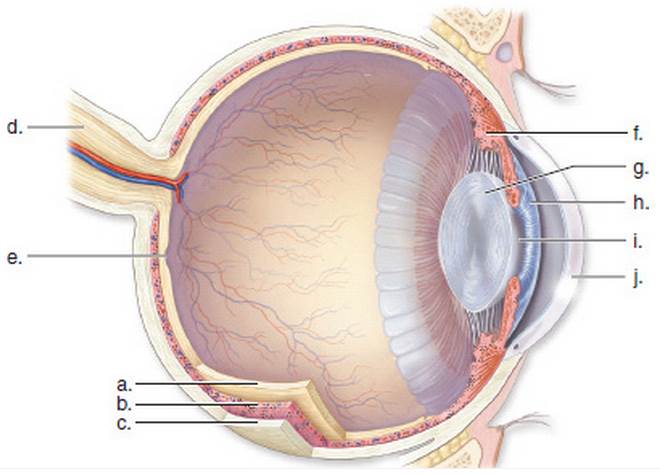
Inquiry into Life
14th Edition
ISBN: 9780073525525
Author: Mader, Sylvia S./
Publisher: McGraw-Hill College
expand_more
expand_more
format_list_bulleted
Concept explainers
Textbook Question
Chapter 18, Problem 5A
Label the following diagram of the human eye.

Expert Solution & Answer
Want to see the full answer?
Check out a sample textbook solution
Students have asked these similar questions
What is the difference between Uniporters, Symporters and Antiporters? Which of these are examples of active transport?
What are coupled transporters?
What are “domains” and how do they aid in protein function?
Chapter 18 Solutions
Inquiry into Life
Ch. 18.1 - Prob. 1LOCh. 18.1 - Prob. 2LOCh. 18.1 - Prob. 3LOCh. 18.1 - Describe how interoceptors often involved in...Ch. 18.1 - Prob. 2CYPCh. 18.1 - Prob. 3CYPCh. 18.2 - Prob. 1LOCh. 18.2 - Prob. 2LOCh. 18.2 - Prob. 3LOCh. 18.2 - Prob. 1CYP
Ch. 18.2 - Prob. 2CYPCh. 18.2 - Prob. 3CYPCh. 18.3 - Prob. 1LOCh. 18.3 - Prob. 2LOCh. 18.3 - Prob. 3LOCh. 18.3 - Prob. 1CYPCh. 18.3 - Prob. 2CYPCh. 18.3 - Prob. 3CYPCh. 18.4 - Prob. 1LOCh. 18.4 - Prob. 2LOCh. 18.4 - Prob. 3LOCh. 18.4 - Prob. 4LOCh. 18.4 - Prob. 1CYPCh. 18.4 - Prob. 2CYPCh. 18.4 - Prob. 3CYPCh. 18.4 - Prob. 4CYPCh. 18.5 - Prob. 1LOCh. 18.5 - Describe the mechanism by which sound waves in the...Ch. 18.5 - Prob. 3LOCh. 18.5 - Prob. 1CYPCh. 18.5 - Prob. 2CYPCh. 18.5 - Prob. 3CYPCh. 18.5 - Prob. 4CYPCh. 18.6 - Prob. 1LOCh. 18.6 - Prob. 2LOCh. 18.6 - Prob. 3LOCh. 18.6 - Prob. 1QTCCh. 18.6 - Prob. 2QTCCh. 18.6 - Prob. 3QTCCh. 18.6 - Prob. 1CYPCh. 18.6 - Prob. 2CYPCh. 18.6 - Prob. 3CYPCh. 18.7 - Prob. 1LOCh. 18.7 - Explain the anatomical abnormalities that cause...Ch. 18.7 - Prob. 3LOCh. 18.7 - Prob. 4LOCh. 18.7 - Prob. 1QTCCh. 18.7 - Prob. 2QTCCh. 18.7 - Prob. 3QTCCh. 18.7 - Prob. 1CYPCh. 18.7 - Prob. 2CYPCh. 18.7 - Prob. 3CYPCh. 18.7 - Prob. 4CYPCh. 18 - Prob. S11.4BYBCh. 18 - Prob. F17.1BYBCh. 18 - Section 17.3 What are the function of the primary...Ch. 18 - Prob. 1CSCh. 18 - Prob. 2CSCh. 18 - Prob. 3CSCh. 18 - Prob. 1ACh. 18 - Prob. 2ACh. 18 - Prob. 3ACh. 18 - Prob. 4ACh. 18 - Label the following diagram of the human eye.Ch. 18 - Prob. 6ACh. 18 - Prob. 7ACh. 18 - Prob. 8ACh. 18 - Prob. 9ACh. 18 - Prob. 10ACh. 18 - Prob. 11ACh. 18 - Prob. 12ACh. 18 - Prob. 13ACh. 18 - Prob. 14ACh. 18 - Prob. 15ACh. 18 - Prob. 1TCCh. 18 - Prob. 2TCCh. 18 - Prob. 3TC
Knowledge Booster
Learn more about
Need a deep-dive on the concept behind this application? Look no further. Learn more about this topic, biology and related others by exploring similar questions and additional content below.Similar questions
- What are intrinsically disordered proteins, and how might they be useful for a living system?arrow_forwardWhat are Amyloid Fibrils? What biological functions are these known to perform?arrow_forwardHow do histamine and prostaglandins help in the mobilization of leukocytes to an injury site? What are chemotactic factors? How do they affect inflammation process?arrow_forward
- Compare and contrast neutrophils and macrophages. Describe two ways they are different and two ways they are similar.arrow_forwardDescribe the effects of three cytokines (not involved in the initial inflammation response). What cells release them?arrow_forwardDescribe activation of helper T cells or cytotoxic T cellsarrow_forward
- Compare and contrast MHC 1 and MHC 2. Describe two way they are different and two ways they similar including how they are used in antigen presentation.arrow_forwardDescribe two antimicrobial properties of the skin.arrow_forwardDescribe how the inflammation response starts including the sentinel cells and the chemicals involved. How do pathogens trigger the response particularly in the skin?arrow_forward
- How does complement promote the immune response? Describe three waysarrow_forwardWhich of the following is not a possible mechanism for autoimmunity? Select one: A. Abnormal expression of MHC II molecules in non-antigen-presenting cells B. Activation of polyclonal B cells C. Polymorphism of HLA alleles D. Molecular mimicry E. Release of sequestered antigensarrow_forwardWRITTEN WORK 3: NON-MENDELIAN GENETICS Part A: Complete the Punnett square and calculate for the probability of genotype and phenotype. i i Genotype: Phenotype: 08:55arrow_forward
arrow_back_ios
SEE MORE QUESTIONS
arrow_forward_ios
Recommended textbooks for you
 Biology 2eBiologyISBN:9781947172517Author:Matthew Douglas, Jung Choi, Mary Ann ClarkPublisher:OpenStax
Biology 2eBiologyISBN:9781947172517Author:Matthew Douglas, Jung Choi, Mary Ann ClarkPublisher:OpenStax Human Biology (MindTap Course List)BiologyISBN:9781305112100Author:Cecie Starr, Beverly McMillanPublisher:Cengage Learning
Human Biology (MindTap Course List)BiologyISBN:9781305112100Author:Cecie Starr, Beverly McMillanPublisher:Cengage Learning Human Physiology: From Cells to Systems (MindTap ...BiologyISBN:9781285866932Author:Lauralee SherwoodPublisher:Cengage Learning
Human Physiology: From Cells to Systems (MindTap ...BiologyISBN:9781285866932Author:Lauralee SherwoodPublisher:Cengage Learning Principles Of Radiographic Imaging: An Art And A ...Health & NutritionISBN:9781337711067Author:Richard R. Carlton, Arlene M. Adler, Vesna BalacPublisher:Cengage Learning
Principles Of Radiographic Imaging: An Art And A ...Health & NutritionISBN:9781337711067Author:Richard R. Carlton, Arlene M. Adler, Vesna BalacPublisher:Cengage Learning



Biology 2e
Biology
ISBN:9781947172517
Author:Matthew Douglas, Jung Choi, Mary Ann Clark
Publisher:OpenStax

Human Biology (MindTap Course List)
Biology
ISBN:9781305112100
Author:Cecie Starr, Beverly McMillan
Publisher:Cengage Learning

Human Physiology: From Cells to Systems (MindTap ...
Biology
ISBN:9781285866932
Author:Lauralee Sherwood
Publisher:Cengage Learning

Principles Of Radiographic Imaging: An Art And A ...
Health & Nutrition
ISBN:9781337711067
Author:Richard R. Carlton, Arlene M. Adler, Vesna Balac
Publisher:Cengage Learning
Dissection Basics | Types and Tools; Author: BlueLink: University of Michigan Anatomy;https://www.youtube.com/watch?v=-_B17pTmzto;License: Standard youtube license